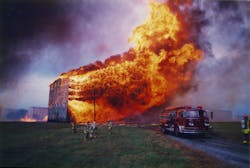Key Takeaways
- The Bardstown, KY, Fire Department built a foam trailer that equips it to conduct offensive attack at a fire at a bourbon distillery rickhouse.
- The addition of aerators to the tip on aerial apparatus provides better aeration of foam that's produced by a foam injection metering module (FIMM).
- Sprinkler systems, lightning arrestors, underground wiring and berms were mandated in bourbon distillery rickhouse design after the 1996 fire at the Heaven Hill Distillery.
On Nov. 7, 1996, the Bardstown-Nelson County, KY, Volunteer Fire Department was dispatched for a report of a bourbon rickhouse on fire. When Chief Jim Akin reached the scene three minutes later, he found heavy smoke coming from Rickhouse I and heavy flames in the upper floors. Akin decided not to conduct an offensive fire attack on the rickhouse because of the amount of fire involvement. He instructed crews to conduct defensive operations to protect exposure Rickhouse J. Akin requested mutual aid from all other seven volunteer Nelson County departments. None of the county departments had an aerial device, and Akin knew that aerials would be paramount in protecting the other seven-story rickhouses. He requested aerial devices from neighboring counties and cities. All in all, 17 departments responded to the incident.
Wind gusts of 70 mph hindered the operation and fueled the fires. With the heights of the fire, the extreme wind conditions and the release of the bourbon from its containment, firefighting efforts were difficult, including to keep the radiant heat from igniting other warehouses. (A total of seven warehouses were lost that day.)
This was one of the costliest fires in Kentucky’s history. This fire had an estimated loss value of $150 million–$200 million. (Bourbon must age for four years before it can be bottled and distributed; the loss of 4.3 million gallons of bourbon was felt for several years for Heaven Hill.)
The Bureau of Alcohol, Tobacco, Firearms and Explosives investigated the cause of the fire. Ultimately, cause was deemed as undetermined. However, a couple hypotheses were developed. One hypothesis was that Rickhouse I was struck by lightning as a storm that produced frequent lightning strikes moved through the area prior to the fire. The second hypothesis: The 70-mph wind gusts caused the above-ground electrical line to be blown into the side of the structure, contacting the metal façade. This contact caused an arc to occur, which ignited the wooden frame behind the façade.
These hypotheses, along with other research, helped to create changes within the design and protection of these structures.
The rickhouse
Bardstown is trademarked as “The Bourbon Capital of the World.” As you drive through the beautiful rolling hills of Bardstown and Nelson County, you see more than 100 of these rickhouses distributed throughout.
Rickhouses first were built in the late 1800s, and there hasn’t been much design change in the actual structural components from that time.
Within the Nelson County community, rickhouses contain 7,000 barrels, 22,000 barrels and 55,000 barrels, respectively.
These seven-story structures are built of all timber. The timber is sawn on site, assembled in portions on the ground, raised by crane and connected to the structure. There’s no containment between floors, as the dunnage portion is open from floor to ceiling.
On each floor, there are walkways on the inside perimeter and in the center. These walkways are where workers load, unload and rotate the barrels. Within these walkways is lighting that must conform to Class I Division II code.
In 22,000-barrel rickhouses, there’s an open elevator shaft on one end of the building; in 55,000-barrel rickhouses, there are elevator shafts at both ends of the building. These shafts help to transport the barrels to the floor where they will be housed.
The foundation of the building is a limestone base with concrete foundation on the outside and several walls running parallel. These walls allow the weight of the structure to be distributed from the post through to the foundation. The foundation also acts as product leak containment. The containment basin can hold approximately 10 percent of the bourbon that’s housed in the rickhouse. Within the top portion of the containment basin are ventilation openings.
The rickhouse is designed for natural ventilation, with air entering the ventilation openings on the containment basin and exiting the ridge cap on the roof. This ventilation allows for the release of bourbon vapors that escape the barrels during the hot months and aids in the aging process of the bourbon.
The rickhouses must be loaded strategically to ensure that the building stays in plumb. (A lot of weight is distributed through a wooden structure.) Plumb bobs are placed through the structure, and employees must remain aware of the plumb bobs’ positions as they load the structure. Construction designs of sway bracing and “buck aisles” help to limit movement within the structure.
Properties of bourbon
Bourbon’s chemical name is ethanol. The properties of ethanol are:
- Vapor is heavier than air.
- Liquid is lighter than water.
- Flashpoint is 55 degrees Fahrenheit.
- Lower explosive limit (LEL) is 3.3 percent; upper explosive limit (UEL) is 19 percent.
- Immediately dangerous to life or health (IDLH) is 3,300 ppm.
- Miscibility: Generally, 3 parts water to 1 part ethanol for dilution for extinguishment.
Changes since 1996
The 1996 fire at Heaven Hill instituted several changes in fire protection and some in building design. Some of these changes were lessons learned, and some were mandated by insurance companies because of the huge loss that was associated with these types of fires.
In 1996, none of the 22,000-barrel rickhouses contained a sprinkler system. Since that time, most insurance companies require that bourbon companies retrofit these warehouses with sprinkler systems. The 55,000-barrel rickhouses were required to have a sprinkler system because of fire and building code.
The sprinkler systems in these rickhouses have total coverage on the fourth and seventh floors and only in the walkways on the other floors. The sprinkler systems are dry systems, because these buildings aren’t heated, and Kentucky has very cold temperatures in the winter.
Lightning arrestors and underground wiring were added. This helps to address the hypothesis that was created during the investigative phase of the 1996 fire.
Additional containment was added on the grounds that surround the rickhouses. Berms were added to help to direct the flow of released bourbon from the rickhouses to the outdoor containment. (The outdoor containment is designed to hold the contents of one rickhouse and 20 minutes of sprinkler system water discharge.)
With these changes, failure points have been reduced.
Firefighting tactical changes
Although most of this article focuses on a fixed facility, large amounts of bourbon are transported on the roadways and via rail. In 2021, the Bardstown Fire Department started to make significant changes to its operation.
First, equipment capabilities were analyzed, and deficiencies were addressed. A foam trailer that has five 275-gallon totes of AR-AFFF environmentally friendly foam and two 2,000-gpm foam educting nozzles with 2½-inch intakes on each nozzle was built. Foam is capable of being educted directly from the totes to support the nozzles. The trailer is pulled by the department’s brush truck, which has a pump. The pump is used to pump foam from the totes to a foam injection metering module (FIMM) that’s connected to the intake of an apparatus.
The FIMM allows any apparatus to be turned into a foam-producing apparatus. This occurs by metering the foam that enters into the pump intake based on the amount of gpm that’s discharged and the percentage of foam that’s required for the product. Aerators were added to the department’s aerial tip to allow better aeration of the foam that’s produced from the FIMM.
The department’s newest apparatus, a 2022 Rosenbauer pumper, has a 100-gallon foam cell that has a Williams Fire & Hazard Control around-the-pump foam system.
With the changes in the building and fire protection systems within the rickhouses, the department believes that it now has the opportunity to conduct an offensive fire attack on a rickhouse fire. With the building being sprinklered, the department now gets early notification that a fire is occurring. This wasn’t the case in 1996.
Generally, the fire should start as a Class A fire, because there are no failure points in the racks themselves that would cause a Class B fire to occur. The sprinkler system should be capable of keeping the fire in check until department arrival, which should occur within 5–8 minutes. If product were to escape, it would drop to the containment basin of the structure.
The department’s standard operating guidelines to combat these types of fires: When notified of an activated alarm at a rickhouse, crews will conduct a risk analysis from the exterior and decide whether an offensive or defensive fire attack should occur. If nothing is showing on arrival, the first-arriving crew will enter the structure with a rope bag. Crew members will listen and use their thermal imaging cameras to try to locate the activation of the sprinkler head or any heat signatures. They will advance to the fire floor and drop the rope bag down the open elevator shaft. The engineer will tie the rope to a 2½-inch hoseline that has a combination nozzle attached. The engineer will set the proper foam percentage for a polar solvent fire, and the fire crew will advance the line for fire attack.
Incoming apparatus can provide positive water supply, because there are hydrants on both ends of the rickhouses.
After the engineer establishes water and foam for the interior crew, the engineer will set up a monitor nozzle at the containment basin. This monitor nozzle helps to dilute any bourbon that’s on fire and, hopefully, extinguish any fire that might have dropped down into the containment basin.
While this occurs, an aerial device will be set up as close to the fire origin as possible through a window. This will allow 1,250 gpm of water to be applied if the interior crew is unsuccessful.
If the fire continues to grow, crews will evacuate and set up defensive operations to protect other rickhouse exposures.
Catalyst for change
The Heaven Hill Fire became a catalyst in the necessary changes that were needed to prevent or reduce this type of huge financial loss. The changes occurred through lessons learned and new restrictions from insurance companies. The department made necessary changes in its operation and equipment to help to protect “The Bourbon Capital of the World.”
About the Author

Todd Spalding
Todd Spalding has more than 23 years of experience in the fire service, including 12 years in a full-time capacity. He has served as the fire chief of the Bardstown, KY, Fire Department for the past three years. Spalding holds a bachelor's degree in fire administration and is a certified fire investigator through the International Association of Arson Investigators.
